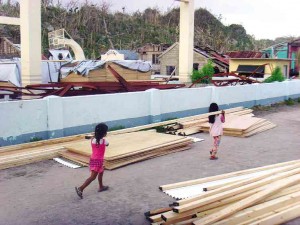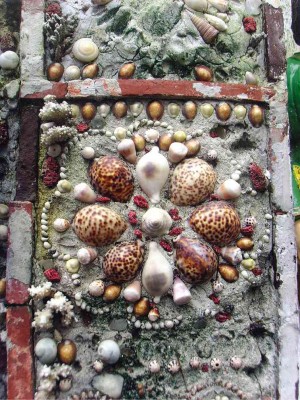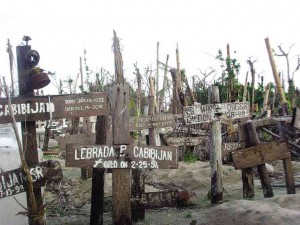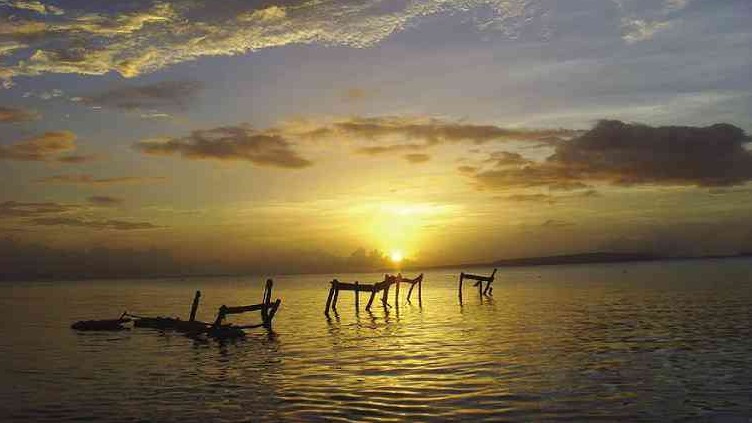

“Tindog, sinirangan Visayas!”
Amid the debris from the heavily damaged municipal hall, a government employee in Guiuan, Eastern Samar, reports to work wearing a shirt with this message of hope, urging the entire region to rise up after Supertyphoon “Yolanda” brought massive destruction in many parts of the country last month.
The entire town is devastated, with coastal and island communities reduced to rubble. The Church of the Immaculate Conception, declared by the National Museum a National Cultural Treasure (NCT), and the American-era regional trial court building, which was supposed to be converted into a municipal museum, did not escape the typhoon’s wrath. Both are now in ruins.
A month later, government has shifted to reconstruction and rehabilitation. Mayor Christopher Sheen Gonzales plans to relocate the affected families, particularly those living along the shores of the poblacion.
The mayor is also looking for people to donate boats since many were destroyed. About 80 percent of Guiuan folks rely on fishing as main livelihood.
A semblance of normalcy can now be seen in the town, with some shops already open and people to their daily routine.

The church, first built by the Jesuits in the 16th century, suffered the same fate as those churches affected by the earthquake in on October. Three-fourths of the structure have been damaged.
Aside from being listed as an NCT, the church is on the tentative list of the United Nations Educational, Scientific and Cultural Organization (Unesco) World Heritage sites, along with the churches of Boljo-on (Cebu); Loboc (Bohol); Lazi (Siquijor); and Tumauini (Isabela).
According to professor Eric Zerrudo of the Center for Conservation of Cultural Property and Environment in the Tropics (CCCPET) of the University of Santo Tomas, the Guiuan church has high values in historicity, authenticity and integrity.
“Historicity, it’s a given; it’s well-documented. Authenticity, because intervention works are very minimal; nothing much has been changed in the church. Integrity, because the architectural and aesthetic details reflect the period when the church was constructed,” said Mr. Zerrudo, who is also the Philippine representative to the World Heritage Committee of Unesco.
New church
The edifice is the only church in the country using shell ornamentations in its interior, particularly the side chapels.

Angel Bautista, chief of the cultural properties division of the National Museum, said he had identified around 100 species of sea shells, including the rare golden cowrie, on these adornments.
Luckily, these ornamentations are still intact except for some loose pieces.
Monsignor Lope Robredillo, the parish priest, said Yolanda was merely the coup de grace since the church’s foundation had been weakened by the earthquake that hit Samar last year.
Robredillo explained the façade suffered a crack and its retablo tilted as a result of the 7.6-magnitude offshore quake in August 2012.
He recalled telling himself that he thought the church would collapse with another earthquake or a very strong typhoon.
Among those damaged or destroyed by Yolanda were the old canvas paintings of the Stations of the Cross; the painted ceiling; the retablo and the santo which are still under the rubble.
Robredillo said he coordinated with the National Museum for the retrieval of church objects littering the church interior, adding there was no case of looting in the church.
The plan now is to build a new church while the damaged one is being rebuilt. According to Robredillo, could take 15 years.
“The church leaders approve my plan to build a new church on the western side of the ruined church. We formed a committee for that purpose,” he said.
The priest also disclosed that, during the 1897 typhoon, the belfry was damaged and the roof was blown off.
According to him, church records show that the day after that storm, 80 people were buried in the town’s cemetery.
That same storm also affected the same municipalities affected by Yolanda last month.
Suluan Island
Yolanda first made a landfall in Guiuan, particularly in the island-barangay of Suluan, a three-hour motorboat ride from the town proper.
The trip to this island of white-sand beaches, waterfalls and caves can be harrowing, with swells reaching as high as 15 feet.
Remote as it may be, Suluan Island has its contribution to Philippine history.

Ferdinand Magellan stayed on this island for a few days before meeting the locals of the nearby island of Homonhon, where the first Mass in the country was held.
It is also where the first liberation group of the Allied Forces landed to secure and prepare the island of Leyte for the arrival of the returning American forces headed by Gen. Douglas MacArthur.
Yolanda brought devastation on this island. The strong winds and the chest-high storm surge destroyed everything on it, including the people’s main source of livelihood, motor boats.
But despite feeling the strongest winds of the storm, there were no reported casualties on the island.
“The people here were able to survive because we hid inside our concrete restrooms,” local Tata Magañan said in Filipino.
Help had arrived from countries such as Canada and the United States.
Sagwan Guiuan boat drive
The University of Santo Tomas Graduate School, particularly its faculty and students under its Master of Arts in Cultural Heritage Studies program, along with the Integrated Conservation Unlimited and scholars from Hong Kong and Japan, organized a boat drive to raise funds for the purchase of new boats for the fishing community of Suluan ravaged by Yolanda.
Zerrudo led a team to the island the other week to survey the damage to the the community and determine how many new boats were needed.
“We have chosen Suluan because it’s where Yolanda first made a landfall in the Philippines,” said Zerrudo. “It is one of the smallest barangays in Guiuan, so the boat drive is feasible. It is one of the most beautiful islands in the country, with precipice caves, breathtaking peaks, centuries-old mangroves, and pristine beaches.”
Zerrudo, a former director of the Government Service Insurance System (GSIS) Museum and the Metropolitan Museum of Manila (MET), earlier said studies must be made about the Guiuan church, such as “manual documentation, X-ray of the whole building, and a new detailed engineering study.”
The studies, he explained, are “for documentation purposes and the checking of (the church’s) structural stability.”
“This overall study will also be the basis of the intervention needed for the church—be it restoration, reconstruction or redevelopment.”
The church is well-documented, so measures could be determined soon.
“The church is well-documented as a result of the cultural mapping project done in 2011,” Zerrudo said.













































